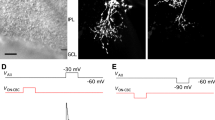Summary
A new method of microstimulation of the blowfly eye using corneal neutralization was applied to the 6 peripheral photoreceptor cells (R1–R6) connected to one neuro-ommatidium (and thus looking into the same direction), whilst the receptor potential of a dark-adapted photoreceptor cell was recorded by means of an intracellular microelectrode. Stimulation of the photoreceptor cells not impaled elicited responses in the recorded cell of about 20% of the response elicited when stimulating the recorded cell. This is probably caused by gap junctions recently found between the axon terminals of these cells. Stimulation of all 6 cells together yielded responses that were larger and longer than those obtained with stimulation of just the recorded cell, and intensity-response curves that deviated more strongly from linearity. Evidence is presented that the resistance of the axon terminal of the photoreceptor cells quickly drops in response to a light flash, depending on the light intensity. Incorporating the cable properties of the cell body and the axon, the resistance of the gap junctions, and the (adapting) terminal resistance, a theoretical model is presented that explains the measurements well. Finally, it is argued that the gap junctions between the photoreceptor cells may effectively uncouple the synaptic responses of the cells by counteracting the influence of field potentials.
Similar content being viewed by others
References
Attwell D, Wilson M, Wu SM (1984) A quantitative analysis of interactions between photoreceptors in the salamander (Ambystoma) retina. J Physiol 352:703–737
Chi C, Carlson SD (1976) Close apposition of photoreceptor cell axons in the house fly. J Insect Physiol 22:1153–1157
Detwiler PB, Hodgkin AL, McNaughton PA (1978) A surprising property of electrical spread in the network of rods in the turtle's retina. Nature 274:562–565
Dubs A (1981) Non-linearity and light adaptation in the fly photoreceptor. J Comp Physiol 144:53–59
Dubs A, Laughlin SB, Srinivasan MV (1981) Single photon signals in fly photoreceptors and first order interneurons at behavioural threshold. J Physiol 317:317–334
Franceschini N (1975) Sampling of the visual environment by the compound eye of the fly: Fundamentals and appli cations. In: Snyder AW, Menzel R (eds) Photoreceptor Optics. Springer, Berlin Heidelberg New York, pp 98–125
French AS, Kuster JE (1985) Nonlinearities in locust photoreceptors during transduction of small numbers of photons. J Comp Physiol A 156:645–652
Hardie RC, Franceschini N, Ribi W, Kirschfeld K (1981) Distribution and properties of sex-specific photoreceptors in the flyMusca domestica. J Comp Physiol 145:139–152
Hardie RC (1984) Functional organization of the fly retina. In: Ottoson D (ed) Progr sensory physiol, vol 5. Springer, Berlin Heidelberg New York Tokyo, pp 1–79
Hateren JH van (1984) Waveguide theory applied to optically measured angular sensitivities of fly photoreceptors. J Comp Physiol A 154:761–771
Hateren JH van (1985) The Stiles-Crawford effect in the eye of the blowfly,Calliphora erythrocephala. Vision Res 25:1305–1315
Hateren JH van (1986) An efficient algorithm for cable theory, applied to blowfly photoreceptor cells and LMC's. Biol Cybern (in press)
Hirosawa K, Hotta Y (1982) Morphological analysis of photoreceptor membranes in mutantDrosophila eyes. In: Hollyfield JG (ed) The structure of the eye. Elsevier North Holland, Amsterdam, pp 45–53
Jack JJB, Noble D, Tsien RW (1975) Electric current flow in excitable cells. Clarendon Press, Oxford
Kirschfeld K, Franceschini N (1968) Optische Eigenschaften der Ommatidien im Komplexauge vonMusca. Kybernetik 5:47–52
Koch C (1984) Cable theory in neurons with active, linearized membranes. Biol Cybern 50:15–33
Koch C, Poggio T (1985) A simple algorithm for solving the cable equation in dendritic trees of arbitrary geometry. J Neurosci Meth 12:303–315
Laughlin SB, Lillywhite PG (1982) Intrinsic noise in locust photoreceptors. J Physiol 332:25–45
Loewenstein WR (1975) Permeable junctions. In: Cold Spring Harbour Symp Quant Biol XL:49–63
Matic T, Laughlin SB (1981) Changes in the intensity-response function of an insect's photoreceptor due to light adaptation. J Comp Physiol 145:169–177
Muijser H (1979) A micro-electrode amplifier with an infinite resistance current source for intracellular measurements of membrane potential and resistance changes under current clamp. Experientia 35:912–913
Pick B (1977) Specific misalignments of rhabdomere visual axes in the neural superposition eye of dipteran flies. Biol Cybern 26:215–224
Ribi WA (1978) Gap junctions coupling photoreceptor axons in the first optic ganglion of the fly. Cell Tissue Res 195:299–308
Scholes J (1969) The electrical responses of the retinal receptors and the lamina in the visual system of the flyMusca. Kybernetik 6:149–162
Shaw SR (1975) Retinal resistance barriers and electrical lateral inhibition. Nature 255:480–483
Shaw SR (1981) Anatomy and physiology of identified non-spiking cells in the photoreceptor-lamina complex of the compound eye of insects, especially Diptera. In: Roberts A, Bush BMH (eds) Neurons without impulses. Cambridge University Press, Cambridge, pp 61–116
Shaw SR (1984a) Asymmetric distribution of gap junctions amongst identified photoreceptor axons ofLucilia cuprina (Diptera). J Cell Sci 66:65–80
Shaw SR (1984b) Early visual processing in insects. J Exp Biol 112:225–251
Shaw SR, Stowe S (1982) Freeze-fracture evidence for gap junctions connecting the axon terminals of dipteran photoreceptors. J Cell Sci 53:115–141
Smakman JGJ, Hateren JH van, Stavenga DG (1984) Angular sensitivity of blowfly photoreceptors: intracellular measurements and wave-optical predictions. J Comp Physiol A 155:239–247
Smakman JGJ (1985) Angular and spectral sensitivity of blowfly photoreceptors. Thesis, Groningen University
Torre V, Owen WG (1983) High-pass filtering of small signals by the rod network in the retina of the toad,Bufo marinus. Biophys J 41:305–324
Wunderer H, Smola U (1982) Morphological differentiation of the central visual cells R7/8 in various regions of the blowfly eye. Tissue Cell 14:341–358
Author information
Authors and Affiliations
Rights and permissions
About this article
Cite this article
van Hateren, J.H. Electrical coupling of neuro-ommatidial photoreceptor cells in the blowfly. J. Comp. Physiol. 158, 795–811 (1986). https://doi.org/10.1007/BF01324822
Accepted:
Issue Date:
DOI: https://doi.org/10.1007/BF01324822




